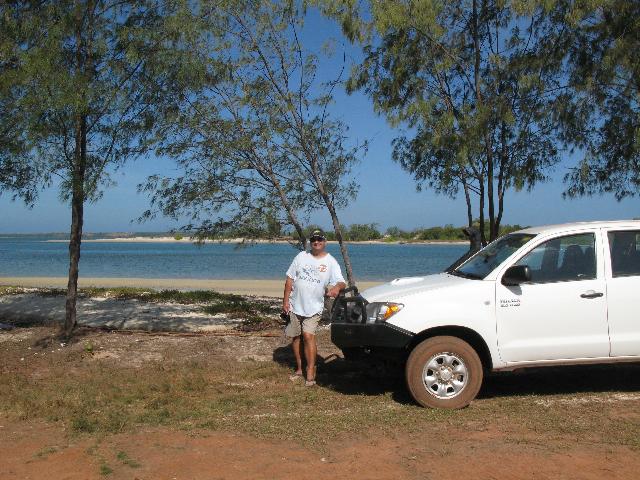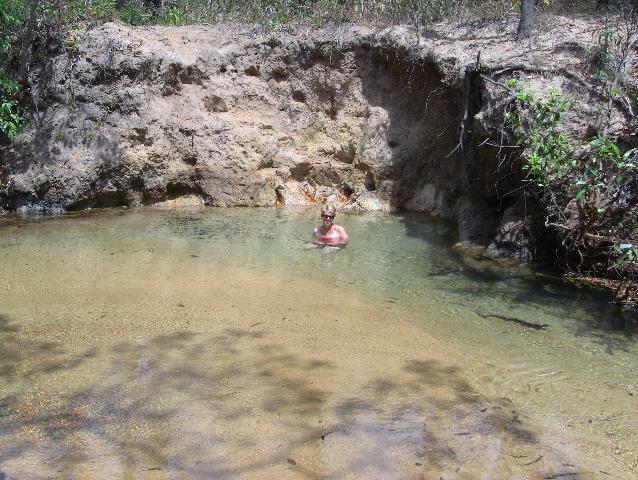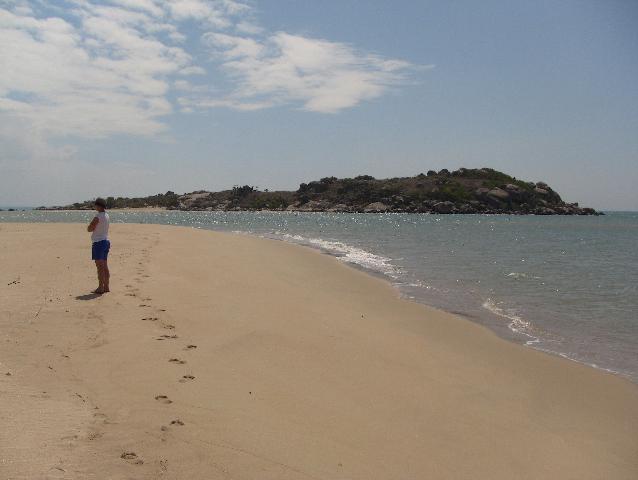
Nhulunbuy
(pronounced Nool-un-boy)
This has been a really hard blog to write as our trip to
Nhulunbuy has created so many questions (and definitely not enough answers)
about Indigenous Australians.
We’ve been to so many places where alcohol is a major
detrimental factor in community life and it’s depressing to see kids not in
school, drunks stumbling around, petrol sniffing, rubbish thrown around, broken
down homes etc. It’s such a
complicated issue, and we’ve spent years questioning how much money is being
invested in trying to turn this around and the enormous medical costs associated
with this alcohol abuse.
Nhulunbuy showed us that traditional life does exist -
alcohol can be banned or monitored, fish are still caught with spears and kids
are in school most of the time. We
did notice though that on ‘family day’ when the pension came out, everyone got
dressed up and caught the bus into town to do the shopping.
Thankfully the local Primary School has a sign clearly declaring it as an
“Alcohol Free Zone” so we knew where we could and couldn’t drink!
There is talent everywhere here – music (home of Yothu
Yindi), art, language and inspiring
leaders trying to help their communities.
But then you see signs about fines for pornography, evidence of petrol
sniffing and the occasional drunk.
And then there’s humbugging. This
eye-opening and shocking article explains:
http://www.theaustralian.com.au/in-depth/aboriginal-australia/bar-humbug/story-e6frgd9f-1111114149020
Rather than try to explain Nhulunbuy, this piece is from
the Visitors Guide: “The township
of Nhulunbuy and the associated Rio Tinto - Alcan bauxite mining operation are
located on leases surrounded by land held under inalienable freehold title by
the recognised Yolnu owners. Yolnu
have designated areas outside the lease areas as recreation areas available to
residents of Nhulunbuy and visitors to the township.“
There are about 3,800 residents.
We were up at 4.30 am to catch the flight from Darwin,
landing at Gove (Nhulunbuy) Airport at 7.30 am.
The plane was full, and apart from 2 other couples who we assumed were
going on to Cairns, we were the only tourists on board, everyone else being
employed by the mine or something to do with mining.
The flight followed the coast from Darwin and over magnificent beaches
and snaking rivers, and we couldn’t wait to get into a boat and go exploring.
The other 2 couples jumped in the shuttle bus with us – so
that made 6 tourists. The Walkabout
is the only hotel in town and after getting the rundown on the place from the
receptionist, we were in our room by 9.30 am.
Certain things needed to be done, and first on the list was to obtain a
Liquor Permit which everyone needs if you’re planning on drinking alcohol.
These can be revoked for a number of reasons, including spending
children’s money on liquor, are involved in alcohol-related domestic violence or
are found humbugging.
Next was to obtain a permit to access the available
recreation areas belonging to the Yolnu, as without a permit we couldn’t even
walk along the beach outside the hotel, let alone anywhere further afield.
By 10.30 am it was 35⁰C and we walked 2 kms to Dhimurru Land Management
Office and paid $35 each to be able to get around, then trudged back to the
hotel and had a swim in the pool.
We were now ready to go exploring, so time to hire a car
and organise a boat trip. To
explore the many tracks and beaches we hired a 4x4 Toyota Hi-Lux ute for 2 days
from Manny who has his own private collection of vehicles he rents out at
exorbitant prices.
We grabbed brochures on cruises to nearby Bremer Island and
made a few phone calls. We compared
notes with the other 2 couples making the same enquiries, and came to the
conclusion that nobody wanted to take our money.
The cruise owners were in Darwin at the time, so a cruise was off the
list. Their business practices
seemed a bit lacking, as Bremer Island had a magnificent resort that this couple
also owned, so it seemed pretty strange that they weren’t around to run it.
We could hire a tinny, but weren’t allowed to go anywhere in it other
than the harbour. We started to
wonder just what we were going to do here for the next 4 days and it wasn’t long
before we realised that this place doesn’t cater much for tourists.
The mine encourages a busy social life for everyone working
here, with about 50 clubs to keep everyone busy, including an Old Codgers AFL,
Deportment and Elegance Academy and a Gun Club.
As we walked into the Walkabout on our first afternoon, a
man wearing a CBC Bearings shirt opened the door for us as he was leaving.
He and Alan recognised each other from 15 years ago, and we spent the
rest of the afternoon and night reminiscing with Garry Tidswell who worked for
CBC Adelaide and was up working with the mine.
We’d already explored all there was to the town which took
about 5 minutes, so we were looking forward to getting out in our car the next
day. Manny dropped the Hilux off at
the Walkabout, and Alan drove him back to his house.
He was gone for ages and when he came back he was a bit rattled as he
found out Manny loved VW Touaregs and quite overbearing, hanging off every word
Alan said. He did say though that
it would be very unacceptable to own one in this part of the country where
Toyota’s rule the road.
Off we headed and drove through the different Indigenous
communities and admired their beautiful beaches, each one with a crocodile
warning sign in English and Aboriginal.
Some tracks were complete washouts, but the Hilux performed well on its
slick tyres, although we did turn around at one stage when one washout turned
into a huge sand pit.

There can’t be a collection of more spectacular beaches in
the world that you can only look at and not swim in.
There was one tiny crystal clear
swimming hole we could swim croc free, although the regular warning sign was
still posted there. After a day
driving around in the heat it was great to wallow in the water keeping a
watchful eye on anything suspicious.
.

.
We drove down to check out the mine operations at the wharf
and met 2 white girls who were fishing with 2 Aboriginal ladies at the boat
ramp. They were respite carers and
told us theirs was the best job in the world. Where else did your work take you
fishing with a picnic on a big blanket with pies from the local bakery and a
small stove to boil the billy. They told
us of a lovely beach that was worth a visit so we drove there on the way back.
They also told us of a man who might hire us his boat, but after a long chat and
promises to contact us, we never heard back from him.

For a tiny town, Nhulunbuy had some nice eating options and
the Arnhem Club had a lovely restaurant with delicious food, also overlooking
the beach, and a well patronised Karaoke night.
We were surprised to see tables of Indigenous and whites
were sitting together enjoying a drink and the singing.
They danced together while a white guy, then a white girl sang.
Then one of the Aboriginal women got up and sang an old Elvis song.
She got the same cheers as everyone else, and it was heart-warming to see
people dancing to her singing. Her
English was a little rusty, but fantastic to watch her.
Excess alcohol consumption by anybody is not tolerated, and
during the Karaoke we saw an Aboriginal guy evicted who had been eyeing off an
old warm beer left behind on the table.
He nonchalantly sat down and was about to start drinking it when a
security guard came up to him, had some serious words, and then promptly removed
him from the club.
On Friday arvo we walked around to the Surf Club for a BBQ
overlooking the beach, where of course we were the only tourists amongst about
200 mine workers and their families.
I don’t think we’ve ever seen so many kids in one place other than in
school, and they were running around tearing the place up having a wild time
while the parents sat and enjoyed the view over a nice cold beer.
We made friends with Pally the injured pelican who didn’t mind at all if
I stuck my arm right down into his beak.
The Surf Club patrols the beach on Sunday where the Nippers
activities are run. This consists of a couple of rubber duckies patrolling the
water to make sure there aren’t any large lizards in the surf waiting for a
snack of children.
After 2 days with a car, we were really at a loose end
without any transport, so we decided to contact Manny again and see if he could
do us a deal on a car for our last day.
We settled on a standard 2WD Toyota Hilux out of his collection.
This was by far the cheapest way for us to get around for the day, then
we could drive ourselves to the airport for our 8.30 pm flight.
Alan was too scared to meet Manny again, so when he dropped the car off
at the Walkabout I took over the transaction while Alan stayed behind.
Having the car also meant we could revisit some of our
favourite places so we decided on a second visit to the Yirrkala Arts Centre.
It was Saturday and lots of local people were also in the centre.
Amongst all the precious bark paintings, woven baskets and burial poles
was the Print Room where kids were crawling over the tables covered with signed
prints and playing on the computer.
A group of Yolnu sat of the floor of the theatre room transfixed watching a
video of a recent burial ceremony.
They laughed at the dancers, or were quite sombre, depending on the ceremony as
it unfolded.
We looked through some folders of available prints and
stumbled on one full of art from the local teenagers.
They’re incredible artists, combining traditional Aboriginal art with
photographic work. We were shocked
to see one painting by a 14 year old Yolnu boy which was a photo of himself
sniffing petrol, with traditional art in the background.
He took this photo as in his words “everyone sniffs petrol here”.
Petrol sniffing is a huge problem in
most Aboriginal communities and here is no different.
It seems to be an accepted thing even though it fries your brain.
On the covered balcony was one of their famous artists
lying on the floor painstakingly creating magnificent art on a burial pole which
will sell for around $7,000.
This tiny area is home to some of Australia’s most
impressive Indigenous artists and their work is displayed in major museums in
Australia and around the world.
Kerry Stokes (Channel 7) has quite a collection, and unfortunately most artwork
was out of our price range. It’s
also home to the didgeridoo (Yidaki).
During our stay we wanted to go to the Yacht Club for lunch
but it’s a $60 return trip by taxi as there’s no other way to get out there as
the bus doesn’t run on Saturdays, and the club doesn’t have a shuttle.
With a car, it was an easy drive out and we had lunch on the lawn
overlooking the beautiful bay, then drove back to town via all our favourite
beaches.
We’d well and truly explored Nhulunbuy as much as we were
allowed, and we both agreed that of all the places we’ve visited since we left
home 6 months ago, Nhulunbuy has left the biggest impression on us.